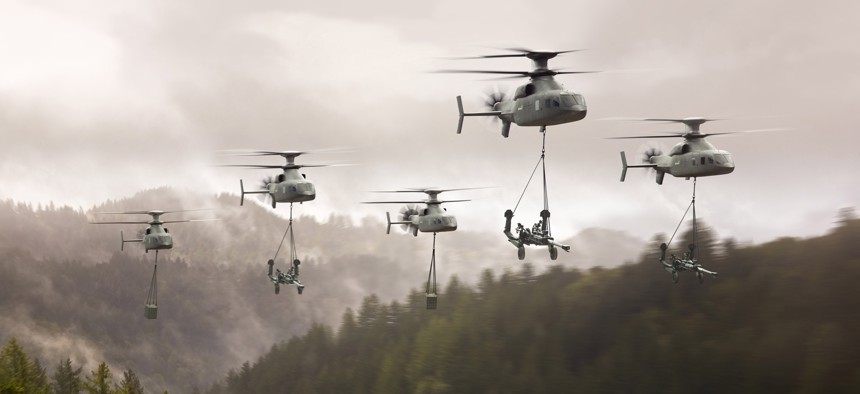
A Sikorsky-Boeing Defiant-X concept image. Sikorsky Boeing
Sikorsky and Boeing Unveil New Helicopter that Could Replace US Army Black Hawk
The coaxial helicopter is based on the companies’ Defiant prototype.
Lockheed Martin’s Sikorsky and Boeing have unveiled a new compound coaxial helicopter that they hope will one day replace the U.S. Army’s venerable Black Hawk helicopter.
The companies billed their Defiant-X as the “fastest, most maneuverable and most survivable assault helicopter in history.” The design is based on the SB>1 tech demonstrator aircraft jointly built by the two companies in recent years.
“We've made some enhancements to design to help reduce thermal signature and improve aerodynamic handling,” Heather McBryan, Boeing’s sales and marketing director for Future Vertical Lift, said in a call with reporters on Friday ahead of Monday’s announcement.
Sikorsky and Boeing executives say their proposed Black Hawk replacement won’t require costly adjustments, such as bigger hangars or parking aprons.
“It requires limited changes to tactics, techniques [and] procedures, [and] also limited changes to training and infrastructure,” McBryan said. “The Defiant-X fits within the same footprint as the Black Hawk and also flies in the same tight formations as the Black Hawk.”
The Sikorsky-Boeing team is competing against Bell to build the Black Hawk replacement, which the Army calls the Future Long-Range Assault Aircraft.
Sikorsky has been working on modern coaxial helicopter designs for more than a decade, beginning with the X2 experimental aircraft in 2008. Then it built the S-97 Raider before teaming up with Boeing to make the SB>1 Defiant.
“We've learned a tremendous amount from all three of these aircraft,” which increased from roughly 6,000 pounds to 30,000, Jay Macklin, Sikorsky’s business development director for Future Vertical Lift, said on the same call.
Sikorsky, Boeing, and Bell have all been working on next-generation helicopter concepts for nearly a decade, all hoping to serve an Army that will eventually look to replace existing rotorcraft with new-generation ones that can fly farther, hit harder, and survive better.
In more recent years, Sikorsky and Boeing have trailed similar development efforts by rival Bell, which flew its V-280 Valor 15 months before the SB>1. The V-280 tilt-rotor aircraft, which can talk off and land vertically like a helicopter, then rotate its engines to fly fast like a fixed-wing plane, has flown more than 150 times and logged more than 200 hours of flight time as of December, according to Bell.
The new Defiant-X will have “speed where it matters” around an objective., Macklin said.
Although not mentioned in the call, Sikorsky and Boeing executives believe the Defiant-X can perform more types of missions than compared to its Bell rival. The companies released concept pictures of a group of helicopters carrying cargo and weapons, a mission traditionally conducted by CH-47 Chinooks, not Black Hawks.




